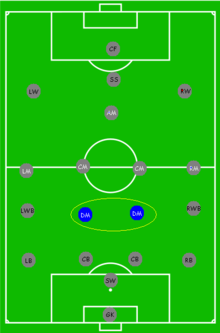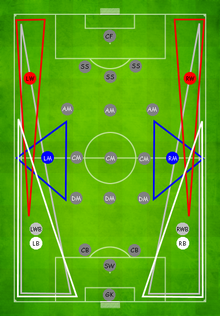Midfielder: Difference between revisions
No edit summary |
|||
| Line 27: | Line 27: | ||
Some [[central midfielder]]s prefer to set up an attack from a withdrawn position. Players with such attributes are often coined ''deep-lying playmakers'', mainly because of their ability to spread play and dictate the game from a withdrawn position. Due to their weaknesses in their defensive aspects, some have to be supported by holding midfielders. Players in this mould include [[Iván Campo]], [[Andrea Pirlo]], [[Xabi Alonso]], [[Michael Essien]] (when he plays for [[Ghana]]), [[Xavi]], [[David Pizarro]], [[Eugenio Corini]], [[Vikash Dhorasoo]], and [[Michael Carrick]]. |
Some [[central midfielder]]s prefer to set up an attack from a withdrawn position. Players with such attributes are often coined ''deep-lying playmakers'', mainly because of their ability to spread play and dictate the game from a withdrawn position. Due to their weaknesses in their defensive aspects, some have to be supported by holding midfielders. Players in this mould include [[Iván Campo]], [[Andrea Pirlo]], [[Xabi Alonso]], [[Michael Essien]] (when he plays for [[Ghana]]), [[Xavi]], [[David Pizarro]], [[Eugenio Corini]], [[Vikash Dhorasoo]], and [[Michael Carrick]]. |
||
This is possibly one of the newest roles in modern football tactics. It is often likened to an evolved version of the old-school [[Football (soccer) positions#Sweeper|sweeper]]. Although it still remains unclear as to who first started playing in this role, [[Josep Guardiola]] has been credited as the player who popularised it. |
This is possibly one of the newest roles in modern football tactics. It is often likened to an evolved version of the old-school [[Football (soccer) positions#Sweeper|sweeper]]. Although it still remains unclear as to who first started playing in this role, [[Josep Guardiola]] has been credited as the player who popularised it, and [[Andrea Pirlo]] the player who perfected it. |
||
=="Box-to-box" midfielders== |
=="Box-to-box" midfielders== |
||
Revision as of 03:04, 19 September 2007
- For the Australian Rules position, see Midfielder (Australian Rules).
In association football, a midfielder is a player whose position of play is midway between the attacking strikers and the defenders (highlighted in blue on the diagram). Their main functions are to dispossess (tackle) the opposing team, to retain possession of the ball, and to feed it to the strikers, and perhaps, to score as well. Some midfielders play a more defensive role, while others blur the boundaries between midfielders and strikers. The number of midfielders a team uses during a match may vary, depending on the team's formation and each individual player's role. The group of midfielders in a team is called midfield.
Outstanding midfielders require a number of skills on top of fitness: they tackle, dribble, shoot, distribute and pass during any match. Most managers field at least one central midfielder with a marked task of breaking up opposition's attacks while the rest are more adept to creating goals or have equal responsibilities between attack and defense. At either side of the pitch a manager can field a winger, a specialist side midfielder used expressedly for attack.
In essence, a good midfield must possess the ability to be combative whilst also being creative. A good striker without midfield support would lack attacking chances, while a defence likewise would be severely tested. Because they occupy the most influential parts of the pitch, midfielders are perhaps more likely to influence the outcome of a match than other positions, especially if they have vision for a good pass or ability to score.
Midfielders typically exhaust the most energy during a match due to the distance they cover on a pitch, as at times they can be called back into defense, or required to attack with the strikers.
Defensive midfielder

A defensive midfielder or a holding midfielder is a central midfielder who is stationed in front of the back defenders for defensive reasons, thus "holding back" the freedom of the opponents to attack. This specialist midfielder's responsibilities are to defend against or tackle the opposing team, to recover the ball for their team, and to safely distribute it to more attacking-minded players.
A secondary role of a defensive midfield player is to initiate attacking movements after they have won the ball (via a legal tackle).
The defensive midfielder position is also referred to in Brazilian Portuguese as "volante" and in South American Spanish as "volante de marca" (Spanish & Portuguese for "Rudder" or someone who gives direction), and in Portugal as a "trinco" (meaning "lock"). Most Brazilian teams deploy at least one "volante" in their team. This includes the Brazilian national team who have fielded some of the most famous defensive midfielders, such as 1994 World Cup winning team captain Dunga.
The position is sometimes overlooked but is critical in the modern game. It is a highly specialized position, executed successfully by only a handful of players.
Perhaps the most typical case of a current defensive midfielder is Claude Makélélé. For both club (Chelsea, Real Madrid) and country (France), he plays in front of the back four, breaking up opposing attacking movements. His tough yet accurate tackling and his 'fail-safe' short passing exemplify the quintessential defensive midfielder. When he played for Real Madrid, the modus operandi had been "Makélélé wins the ball and passes it to Zidane." Since 2005, Makelele has formed a twin defensive midfield pairing with Ghanaian Michael Essien while playing for Chelsea. The role is even often referred to as the 'Makélélé role'.
Other accomplished defensive midfielders playing today include Dietmar Hamann, Abdoulaye Diagne-Faye, Gennaro Gattuso, Esteban Cambiasso, Torsten Frings, Owen Hargreaves, David Albelda, Christian Poulsen, Javier Mascherano, Mahamadou Diarra, Gilberto Silva, Edmilson, and Mohamed Sissoko. Few of these are out and out defensive midfielders in the Makélelé mould. The term "box to box" player (see below) is often used to refer to more dynamic defensive midfielders. During their successful campaign in Euro 2004, Greece frequently used formations that sported three defensive midfielders at the same time (Zagorakis, Katsouranis, Basinas).
Deep-lying playmaker
Some central midfielders prefer to set up an attack from a withdrawn position. Players with such attributes are often coined deep-lying playmakers, mainly because of their ability to spread play and dictate the game from a withdrawn position. Due to their weaknesses in their defensive aspects, some have to be supported by holding midfielders. Players in this mould include Iván Campo, Andrea Pirlo, Xabi Alonso, Michael Essien (when he plays for Ghana), Xavi, David Pizarro, Eugenio Corini, Vikash Dhorasoo, and Michael Carrick.
This is possibly one of the newest roles in modern football tactics. It is often likened to an evolved version of the old-school sweeper. Although it still remains unclear as to who first started playing in this role, Josep Guardiola has been credited as the player who popularised it, and Andrea Pirlo the player who perfected it.
"Box-to-box" midfielders
Certain central midfielders, nicknamed 'box-to-box' players, can play several roles in the game, depending on their particular strengths and the team tactics. They provide the link between defence and attack and can score and defend at either ends of the field. The most versatile of players, they typically possess exceptional stamina and are unusually skilled at tackling, passing, shooting and keeping possession.
Notable examples include Roy Keane, Cesc Fabregas, Michael Ballack, Michael Essien, Patrick Vieira, Rubén Baraja, Frank Lampard, Steven Gerrard, Lucas Leiva, Massimo Donati, Scott Brown and Barry Ferguson. All are/were capable of scoring and defending from "box to box". This section of the field is often known as a team's "engine room", because great teams rarely succeeded without skilful, commanding central midfielders.
Attacking midfielder

An attacking midfielder is any midfielder who is stationed in a more advanced midfield position to assist goalscoring.
The attacking midfielder is an influential position and requires the player to possess good technical abilities, an eye for a pass and sometimes dribbling skills. The attacking midfielder is similar to the playmaker role.
He is typically the offensive pivot of the team; if it is in a centralised position, sometimes known in football as "playing in the hole", although this term can also be used to describe a deep-lying centre forward. This specialist midfielder's main role is to create goal-scoring opportunities for his own team, and perhaps to score himself.
Juan Roman Riquelme, Francesco Totti, Ronaldinho and Kaká are attacking midfielders widely considered to be among the best today; other accomplished players include Deco, Frank Lampard, Pablo Aimar, Paul Scholes, Clarence Seedorf and Juninho Pernambucano.
Winger

A winger is a midfielder who is stationed in a wide position near the touchlines. Wingers such as Stanley Matthews or Jimmy Johnstone used to be classified as forwards in traditional W-shaped formations, and were formally known as "Outside Right" or "Outside Left," but as tactics evolved through the last 30 years, wingers have dropped to deeper field positions. Modern wingers are now usually classified as part of the midfield, usually in 4-4-2 or 4-5-1 formations (but whilst the team is on the attack, they tend to resemble 4-2-4 and 4-3-3 formations respectively).
It is a winger's duty to beat opposing fullbacks and to deliver cut-backs or crosses from wide positions. They are usually some of the quickest players in the team and usually have very good dribbling skills as well. Today, some of the best examples are Cristiano Ronaldo, Aiden McGeady, Mancini, Vicente, Ricardo Quaresma, Yuri Zhirkov, Nani, Joaquin, Mikel Arteta, Arjen Robben, Florent Malouda, Ryan Giggs, and Andres Guardado
Traditionally wingers were purely attacking players who hugged the touch line and were not expected to track back and defend. This began to change around the time of the 1966 World Cup, when England manager Alf Ramsey led a team without natural wingers to the championship. This team was known as the "Wingless Wonders".
This has led to most modern wingers having a more demanding role in the sense that, they are expected to defend and track back to repossess the ball as well as provide skillful crosses for centre forwards and strikers. Sometimes, they are also expected to cover/attack the central area, as well as switch flanks. Technically gifted wingers such as Cristiano Ronaldo, Joaquin, Ricardo Quaresma, Lionel Messi are able to dribble infield and using a plethora of tricks, pass defenders and shoot or set up a teammate. This has made wingers some of the most sought after players in the modern game.
